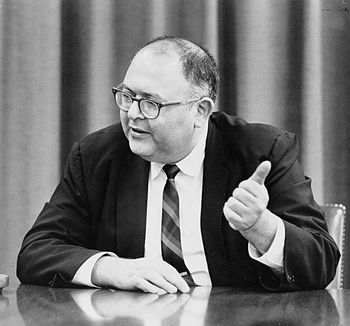A brief history
| Scenario planning for educators | |
|---|---|
| Introduction to scenario planning | Introduction and objectives | Video signpost - Interview with Niki Davis | Definitions | A brief history | e-Learning activity - Discovering scenarios | Anatomy of a scenario | e-Learning activity - Components of a scenario and reflection | FAQs |

The Royal Dutch Shell company pioneered scenario planning in the corporate world, using the methodology to successfully navigate the turbulent oil crisis in the 1970s, when many of their competitors failed to anticipate significant change. Pierre Wack, an eccentric oil executive, developed the scenario planning approach at Shell, working with a team of scenario planners.
| “ | Scenarios deal with two worlds; the world of facts and the world of perceptions. They explore for facts but they aim at perceptions inside the heads of decision-makers. Their purpose is to gather and transform information of strategic significance into fresh perceptions. | ” |
| —Pierre Wack[1] | ||
Today, Shell has a dedicated Scenarios Team which supports executive leadership. The original Shell approach of scenario planning has matured into a powerful technique representing a variety of approaches which force companies to think more critically about the future than conventional forecasting techniques allow. Shell deliberately sets up scenarios at opposite ends of the spectrum, so as to expose managers to alternatives they may not ordinarily see and then asking how they would respond if a particular scenario realised itself. Much of the published literature on scenario planning draws on the pioneering experiences of the Shell Group (Schoemaker 1995[2] & 1998[3]; Schoemaker & Van der Heijden 1992[4]; Van der Heijden 1996[5]).
Reflecting on the Shell experience of scenario planning, Van der Heijden remarks that “[f]orecasting produces answers, but scenario planning had made people ask the crucial questions” (1996: 18) about the future. The inherent power of the technique is that it transcends the “domination of the credible, popular but very wrong imagined future” (Van der Heijden 1996: 18). Shell also discovered the power of using scenarios to accelerate organisational learning, hence Senge’s support for using mental models to promote the ideals of the learning organisation (Senge 1994[6]).
Notes
- ↑ Wack, P. 1985. The Gentle Art of Re-perceiving, Harvard Business Review, September–October.
- ↑ Schoemaker, P.J.H. 1995. Scenario planning: A tool for strategic thinking. Sloan Management Review. 36(2): 25-40.
- ↑ Schoemaker, P.J.H. 1998. Twenty common pitfalls in scenario planning. In Fahey, L & Randall, R.M. (eds.) 1998. Learning from the future. Competitive foresight scenarios. New York: Wiley, John & Sons, Inc.
- ↑ Schoemaker, P.J.H. & van der Heijden C.A.J.M. 1992. Integrating scenarios into strategic planning at Royal Dutch Shell. Planning Review. 20(3): 41-47.
- ↑ Van der Heijden, K. 1996. Scenarios. The art of strategic conversation. Chichester: Wiley, John & Sons.
- ↑ Senge, P.M. 1994. The fifth discipline. The art and practice of the learning organization. New York: Currency Doubleday.